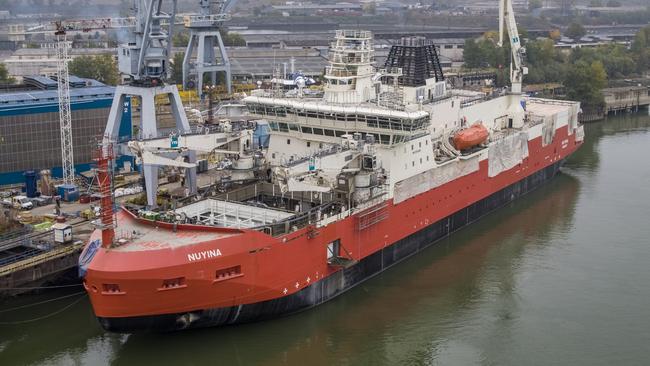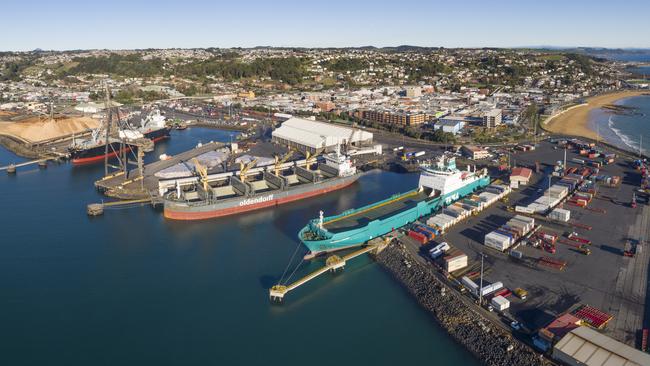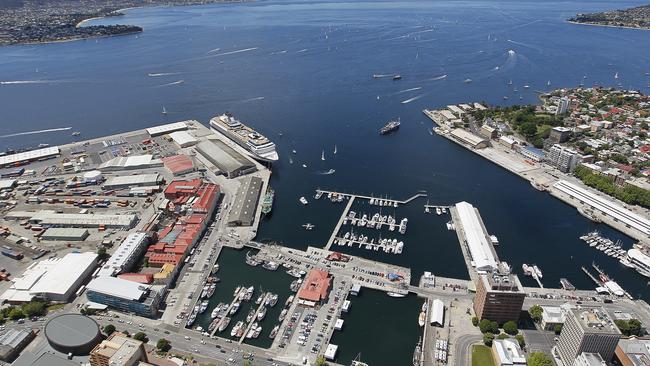Hobart and Burnie ports need work as a priority, says Infrastructure Australia report
The inclusion of a $250m plan to upgrade two of the state’s major ports on a list of priority projects has been welcomed as a “significant step forward” in bringing the projects to fruition.

Tasmania
Don't miss out on the headlines from Tasmania. Followed categories will be added to My News.
- Bridgewater Bridge left off Infrastructure Australia priority projects list
- Hobart house prices defy pandemic expectations
PROPOSALS worth $250 million to upgrade Hobart and Burnie ports are about future-proofing the state’s seaport system, TasPorts says.
TasPorts CEO Anthony Donald said the inclusion of the plans on Infrastructure Australia’s priority project list reflected that commitment.
“In 2018 we released our Port Master Plan – a co-ordinated, statewide vision for the future of
Tasmania’s multi-port system. Both the Port of Hobart and Port of Burnie were integral to this plan and the recognition by Infrastructure Australia in the 2021 Priority List is a significant step forward in realising both of these major initiatives,” Mr Donald said.
The initiatives — a $119 million upgrade of the Port of Burnie to allow it to host bigger ships and a $137 million project to replace the Port of Hobart’s ageing wharf infrastructure and build a new tourist arrival terminal — were the only new Tasmanian projects to make it onto this year’s list.
The Infrastructure Australia report said the current condition of Macquarie Wharves 4, 5 and 6 was limiting tourism growth, trade and the Antarctic exploration sector.
It said Burnie was the only seaport in Tasmania that could expand to be the state’s biggest but it needed to be able to accommodate ships bigger than Handymax size.

But Mr Donald said TasPorts was capable of berthing of RSV Nuyina at the Macquarie wharves and it and the Australian Antarctic Division had signed a new five-year agreement in December.
“This agreement will see a joint investment of $3 million by TasPorts and AAD in minor infrastructure upgrades, including fenders and bollards, to ensure operational efficiencies for the new 160 metre vessel. These works will be completed prior to the vessel’s arrival,” Mr Donald said.
TasPorts’ vision for the Port of Burnie was announced in August last year and Mr Donald said it would enable larger vessels to berth.
Assistant Minister for Industry Development Senator Jonno Duniam said world-class freight and port facilities were important to ensure the success of Tasmania’s renowned producers and other key employment industries.
“We will work hard to ensure the Tasmanian government delivers on these important projects,” Senator Duniam said.
Infrastructure Minister Michael Ferguson said the latest 10-year Tasmanian Infrastructure Pipeline forecast $17.4 billion in planned public economic and social infrastructure investment.
“I welcome the release of Infrastructure Australia’s latest Priority List, which has seen both the Hobart Port Precinct and Port of Burnie capacity improvement projects included for the first time,” Mr Ferguson said.
Labor MP Shane Broad said the state government had not spent a cent on either port project to date.

Port projects win priority status
TWO Tasmanian port upgrade proposals to help the state meet its export, tourism and Antarctic research potential have been added to Infrastructure Australia’s 2021 Priority List.
The port initiatives – upgrading the Port of Burnie so it can take bigger ships and replacing the Port of Hobart’s ageing wharf infrastructure and perhaps build a new tourist arrival terminal – are the only new Tasmanian projects to make it onto this year’s list.
The Infrastructure Australia report says the current condition of Macquarie wharves 4, 5 and 6 was limiting tourism growth, trade and the Antarctic exploration sector.
“The wharf assets are approaching end of life and require significant maintenance each year to sustain a minimal service level,” the report says.
“In its existing condition, the port cannot accommodate the Australian Antarctic Division’s new purpose-built icebreaker RSV Nuyina. It also cannot accommodate the Oasis passenger cruise vessels.”
TasPorts will now look at options to address wharf improvements, supporting infrastructure to increase exports, and a potential terminal and other visitor facilities for tourists.
Infrastructure Australia said Burnie needs to accommodate bigger ships to reach its export potential.
Currently the port cannot accommodate vessels larger than Handymax size, which carry less than 60,000 tonnes.
“These vessels are too small to service the supply chain,” the report says.
“Port of Burnie is Tasmania’s only multi-use seaport capable of expanding to be the state’s largest export gateway for bulk and containerised shipping.”
The Tasmanian government estimates mining and minerals exports could grow from 500,000 tonnes a year in 2019 to 6 million tonnes a year by 2029.
“However, the current port capacity will limit this growth and increase supply chain costs for bulk exporters,” the report says.

Potential options include channel works to accommodate Panamax vessels and upgrading ship-loading infrastructure and transport access to service higher volumes of freight.
A handful of other proposals remain on the list several years after being listed as priority initiatives.
These include the replacement of the Bridgewater Bridge, the University of Tasmania’s STEM project in Hobart and Northern Transformation Project in Launceston, and upgrading the Burnie to Hobart freight corridor.
A new Bridgewater Bridge was added to the list in 2016. The business case for a replacement bridge was evaluated by Infrastructure Australia in June 2019 and the Department of Infrastructure now expects works to start next year with people driving on the link by late 2024.
Across Australia, there were 44 new proposals added to the list from a broad spectrum of transport, energy, water, waste, telecommunications and social infrastructure.
Originally published as Hobart and Burnie ports need work as a priority, says Infrastructure Australia report


